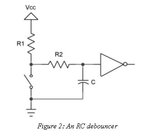chintesh
Newbie level 1
hey guys i have read about the key debouncing concept and methods to remove it with the help of software by increasing the delay but if i want to remove it with the help of capacitors then what values of capacitors and resistors should i use?

